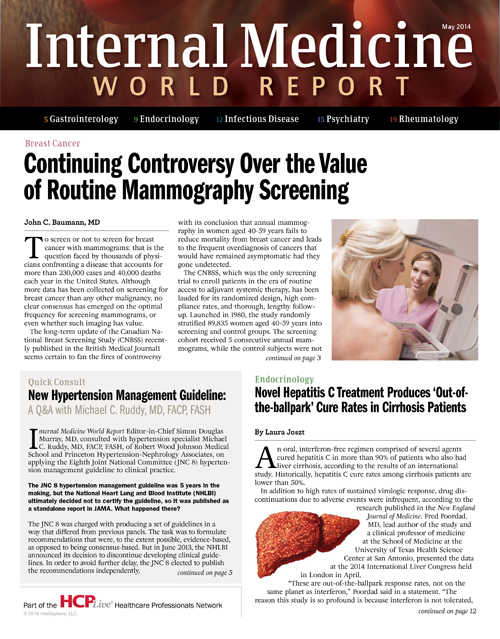Publication
Article
Internal Medicine World Report
Continuing Controversy Over the Value of Routine Mammography Screening
Author(s):
To screen or not to screen for breast cancer with mammograms: that is the question faced by thousands of physicians confronting a disease that accounts for more than 230,000 cases and 40,000 deaths each year in the United States.

To screen or not to screen for breast cancer with mammograms: that is the question faced by thousands of physicians confronting a disease that accounts for more than 230,000 cases and 40,000 deaths each year in the United States. Although more data has been collected on screening for breast cancer than any other malignancy, no clear consensus has emerged on the optimal frequency for screening mammograms, or even whether such imaging has value.
The long-term update of the Canadian National Breast Screening Study (CNBSS) recently published in the British Medical Journal1 seems certain to fan the fires of controversy with its conclusion that annual mammography in women aged 40-59 years fails to reduce mortality from breast cancer and leads to the frequent overdiagnosis of cancers that would have remained asymptomatic had they gone undetected.
The CNBSS, which was the only screening trial to enroll patients in the era of routine access to adjuvant systemic therapy, has been lauded for its randomized design, high compliance rates, and thorough, lengthy follow-up. Launched in 1980, the study randomly stratified 89,835 women aged 40-59 years into screening and control groups. The screening cohort received 5 consecutive annual mammograms, while the control subjects were not invited for periodic imaging, though all of the women received an initial clinical breast examination prior to randomization.
Those aged 40-49 years in the mammography group and all participants aged 50-59 years in both arms of the study received annual breast examinations, while women aged 40-49 years in the control arm received “usual care” from their primary care physicians. The study only considered invasive cancers and did not report on the diagnosis, treatment, or outcomes of non-invasive types.
Like the original CNBSS report,2 this long-term update has already generated intense criticism from some authorities who have questioned its methodology and findings. Although the follow-up report provided no quantitative information about the degree to which the control group was contaminated by women who received mammograms within the community outside of the study, the authors did note that they adjusted for the use of mammography in the control group of women aged 40-49 years in their earlier report and found no evidence to challenge the fundamental findings of their study.
Nevertheless, initial physical examination findings that were suspicious for advanced breast cancer did not exclude patients from the research — a fundamental design flaw for a screening study that should have limited enrollment to asymptomatic women. Although the randomization process was blinded to the results of the initial breast examination, a disproportionate number of women with signs and symptoms suggestive of breast cancer were assigned to the screening cohort.
Such excess of patients with advanced breast cancers in the mammography arm resulted in 115 breast cancer deaths in this group, compared to only 55 deaths in the control arm among patients whose cancers were detected during the first 5 years of the trial. Consequently, this skewed assignment of patients with advanced breast cancers to the mammography group may obscure a potential survival benefit from screening to detect early disease.
During the 5-year screening period, more invasive cancers (n=666) were detected in the mammography group than in the control group (n=534). However, the screening program seemed marginally effective at detecting lesions in an earlier, more curable stage, as only 31.8% of the invasive lesions found in the screened group were identified before they were large enough to be palpable, and the size of the tumors detected by screening was only slightly smaller (1.9 cm, on average) than the size of those detected in the control arm (2.1 cm, on average).
Critics have argued that poor-quality mammography accounted for these findings, since two-thirds of cancers are typically detected by mammography before the lesions are palpable.3-4 Although the CNBSS investigators defended the quality of their mammogram program, outside experts who reviewed the imaging used in this study found multiple deficiencies, including out-of-date mammography equipment, image quality degraded by scattered radiation, and technologists who were not taught proper patient positioning. Even the CNBSS’s own reference physicist admitted “the quality was far below state of the art, even for that time.”5 Failure to detect early, nonpalpable, more readily controlled invasive breast cancers due to poor quality mammography would be expected to increase breast cancer mortality in the screening arm relative to the control group, which might conceal a potential benefit from screening.
As in other trials, early tumor detection appeared to impact treatment outcomes in the CNBSS. For instance, there was a 79.6% 25-year survival rate when lesions were detected before they became palpable, compared to a 66.3% long-term survival rate for palpable tumors. Palpable lesions were also significantly more likely to have axillary nodal metastases than nonpalpable cancers, the presence of which correlates with survival and also subjects many women to the increased morbidity of aggressive adjuvant chemotherapy regimens. The fact that the CNBSS’s mammography regimen detected early, nonpalpable cancers at only half the rate expected from a high-quality, modern mammography program constitutes a limitation in the study which casts doubt on its central conclusion that screening mammograms have no impact on breast cancer mortality.
The study reported equivalent 25-year cumulative breast cancer mortality rates in the 2 participant arms, as 500 patients in the screened group died of the disease compared to 505 in the control group. Since the aim of a screening program is to reduce the mortality rate from breast cancer, the CNBSS investigators concluded their data showed no benefit from screening a population for breast cancer using the techniques employed in the study.
Despite the equivalent breast cancer mortality rates observed in both of the CNBSS study populations, mammography was associated with a survival benefit for women whose disease was detected by screening. Among those patients, the 25-year survival rate was significantly higher than that of control subjects with detected cancers.
This apparent discrepancy between the absence of improved breast cancer mortality rates in the screened population and the improved long-term survival of patients whose disease was detected by screening might be explained by biases resulting from the early detection of slow-growing cancers or the overdiagnosis of neoplasms that would have never become clinically threatening if left undetected. Screening programs certainly result in the diagnosis of some patients with indolent or clinically insignificant breast cancers, and the survival of such patients after diagnosis would create the illusion that mammography contributed to their favorable outcomes, even if it had no effect on overall mortality rates.
The lengthy follow-up period reported in this study should effectively mitigate bias in survival rates associated with the early detection of indolent yet life-threatening cancers, which leaves the overdiagnosis of clinically irrelevant cancers as the presumed explanation for the observed increase in survival rates without a corresponding improvement in breast cancer mortality rates.
The study authors calculated an excess of 106 cancers observed in the mammography cohort, which they attributed entirely to overdiagnosis. While this constituted 22% of all screen-detected invasive cancers and 50% of all mammographically detected yet nonpalpable invasive lesions, it remains unclear how many of the excess cancers in the screening arm represented true overdiagnosis in comparison to the skewed assignment of an excessive number of breast cancer patients to the screening arm of the study.
Since there were an additional 60 breast cancer deaths among women in the screened cohort who were diagnosed with the disease during the first 5 years of the study, it seems as though a significant proportion of the excess cancers ascribed to overdiagnosis reflects a flaw in the randomization process that allowed patients whose initial clinical examination was already suspicious for advanced cancer to be preferentially assigned to the screening arm.
If the screening arm had been populated with a surplus of clinically significant tumors, yet experienced the same number of cancer deaths as the control group, then this would be evidence of a real benefit for screening. Unfortunately, it is impossible to tell from the report whether the excess cancers detected in the screening arm were life-threatening or irrelevant, so the finding of equivalent mortality in both arms of the study cannot be accepted as definitive evidence that mammography has no impact on breast cancer mortality rates, as the authors of the study claimed.
The CNBSS’s fundamental thesis that screening programs with annual mammography fail to reduce breast cancer mortality differs from the findings of other clinical trials which experts such as the US Preventive Services Task Force (USPSTF) and the Independent UK Panel on Breast Cancer Screening rely upon to formulate recommendations regarding breast cancer prevention. While each of those previous randomized trials has methodological problems, the preponderance of expert opinion is that breast cancer screening reduces the relative risk of death by roughly 15% in women aged 40-59 years.
Although the contrary results of the CNBSS are intriguing, thought-provoking, and attracting considerable attention from policymakers and the media, it is unlikely that this study will settle the long-standing controversy over the value of mammography screening. Until more convincing data emerges, clinicians are advised to follow the recommendations of expert panels assembled by the American Cancer Society (ACS) and other specialty societies. While these recommendations vary on when to discontinue screening, they all advise having some reliance on routine mammography.
References
1. Miller AB, et al. Twenty five year follow-up for breast cancer incidence and mortality of the Canadian National Breast Screening Study: randomised screening trial. BMJ. 2014;348:g366. http://www.bmj.com/content/348/bmj.g366.
2. Miller AB, et al. The Canadian National Breast Screening Study-1: breast cancer mortality after 11 to 16 years of follow-up. A randomized screening trial of mammography in women age 40 to 49 years. Ann Intern Med. 2002 Sep 3;1378:305-12. http://www.ncbi.nlm.nih.gov/pubmed/12204013.
3. Mathis KL, et al. Palpable presentation of breast cancer persists in the era of screening mammography. J Am Coll Surg. 2010 Mar;210(3):314-83.
4. Kopans DB, Feig SA. The Canadian National Breast Screening Study: a critical review. AJR. 1993;161:755-60. http://www.ncbi.nlm.nih.gov/pubmed/8372752.
5. Yaffe MJ. Correction: Canada study. Letter to the editor. JNCI. 1993;85:94.
About the Author

John C. Baumann, MD, is Director of Radiation Oncology in the Edward and Marie Matthews Center for Cancer Care at the University Medical Center of Princeton at Plainsboro.






